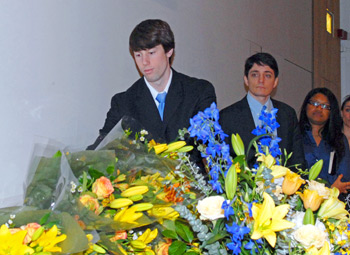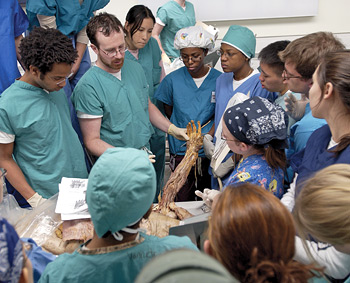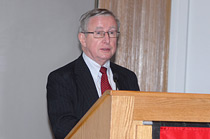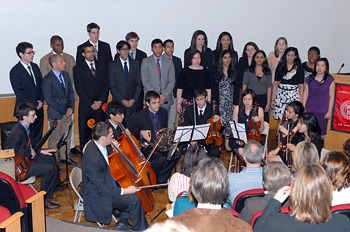Weill Cornell first-year medical students honor donors' ultimate gift

The April 19 ceremony included a flower presentation by each of the 26 first-year anatomy lab groups to honor their donors. Photo by Weill Cornell Art & Photography.
For many medical students, their first-year experiences in the anatomy lab are a turning point, the moment at which concepts about science and medicine become reality. In the anatomy lab, not only do textbook descriptions of human physiology become real, but for the first time in their training, medical students also view medicine through the prism of a patient -- their donor.
On April 19, the entire Weill Cornell Medical College Class of 2014 gathered in Uris Auditorium to honor the gift donors made in giving their bodies to further medical education. Also in attendance were family members, friends and colleagues of the donors.
"Our donors continue to serve and teach, even after death," said Dr. Estomih Mtui, director of WCMC's gross anatomy and body visualization program. "As we say 'thank you' there is also another significant reason for this gathering -- to cherish memories of the men and women who donated their bodies to this medical college."

Weill Cornell Medical College first-year students in anatomy lab. "Our donors continue to serve and teach, even after death," said Dr. Estomih Mtui, director of WCMC's gross anatomy and body visualization program, at the memorial service. Photo by John Abbott.
Addressing the donors' families and friends, medical student Colleen Wichser, president of the 2014 class, said, "I realize this ceremony is inevitably difficult for many, yet I hope this afternoon can also be a time that we celebrate the lives of your loved ones, celebrate their selfless nature and their willingness to give of themselves."
Over four months in the anatomy lab, first-year students translate textbook anatomic descriptions into scientific observation and experience by dissecting donors' bodies. However, when a donor makes a gift of his body to the medical college, it goes far beyond enriching only first-year students. A typical donor will provide a length of study of between 18 and 24 months, serving medical students as well as residents in a number of medical subspecialties, said Dr. Antonio M. Gotto Jr., the Stephen and Suzanne Weiss Dean of Weill Cornell Medical College.
"The gift represents an invaluable contribution to the education of our doctors in training and our medical students," Gotto said. "The donations help humanize the study of medicine by teaching students to appreciate the amazing complexity and beauty of the human body."

Dr. Antonio M. Gotto Jr., the Stephen and Suzanne Weiss Dean of Weill Cornell Medical College, speaks at the ceremony. Photo by Weill Cornell Art & Photography.
Speaking to the families in attendance, Gotto said, "This gift that your loved one has made is truly special and greatly appreciated."
The centerpiece of the memorial service came when students in each of the 26 first-year anatomy lab groups presented a bouquet in honor of each donor.
"As a first-year medical student, I often feel like I don't have a lot to give back, and yet these donors have given us their most intimate secrets, and they ask nothing in return. … I'm very humbled by that, and I think I speak for all of us when I say that," said Peter Barish '14.
"I will now be armed with everything [the donor] taught me, and in this way he will always be with me," said Stacy Chu '14.
For every student, in one way or another, the experience goes beyond simply connecting an anatomic illustration with the living body.
"For many of us, this was our first experience with the nature of death," said Nandita Sriram '14. "Coming to terms with our own mortality is part and parcel of the medical profession, and while that might take a lifetime to achieve, [our donors] have allowed us to begin that process."

Musical performances were given at the event by the WCMC 2014 Mixed Choir and Orchestra and the WCMC 2014 Women's Choir. Photo by Weill Cornell Art & Photography.
For others, the experience translated immediately into daily medical student life.
Corynn Kasap '14 saw a patient in the lung clinic who was suffering pain beneath a scar from a previous surgery that had likely resulted in nerve damage. "As soon as I saw the scar on her incision site," Kasap said, "I also saw our donor, and I was able to really understand what was going on."
Some of the most moving perspectives came from the donors' family members in attendance.
"I had no idea what today would be like because 34 years ago, when I was a medical student, we didn't have anything like this," said Dr. Joanne Jordan, the daughter of a donor. "I would like to thank you very much for calling my dad a donor and not some other words that are inanimate -- thank you for recognizing that they are people," she told students. Because donors are preserved for medical science, families do not get to experience the mourning process of a funeral and burial. Several family members said the memorial service provided a sense of closure.
"As today's testimonials have shown us, the gross anatomy course not only provides future doctors with a fundamental understanding of the human body," said Dr. David Hajjar, dean of the Weill Cornell Graduate School, "but through the compassion of these donors, they've also learned about the human attributes that are really at the heart and soul of medicine -- charity, compassion and consideration, and care for others."
A longer version of this article originally appeared in the April 22, 2011 WCMC Dean's Bulletin. Gabriel Miller is a freelance writer.